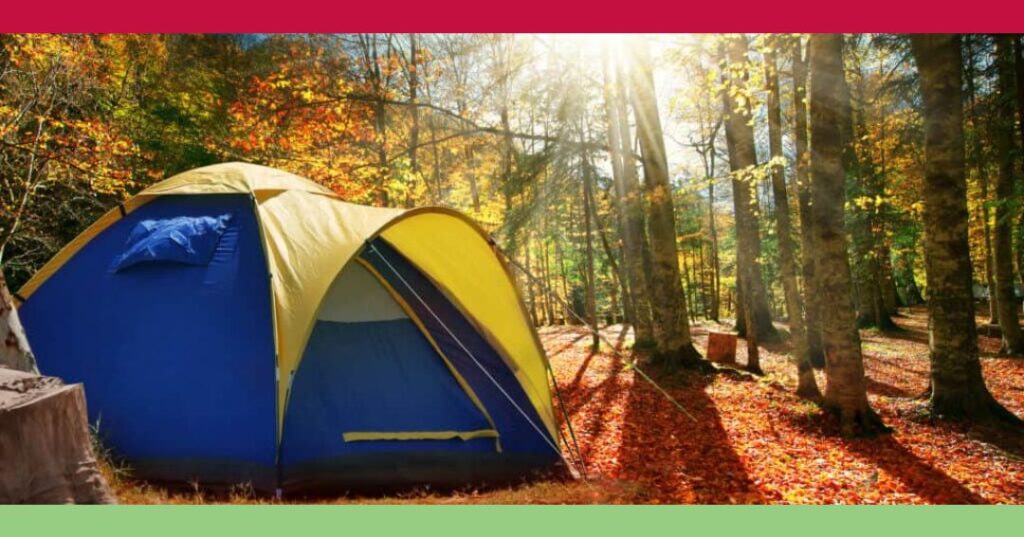As the chill of winter settles over the Midwest, most families are packing away their camping gear until the spring warm-up. Whether your home base is Jellystone Park™ Akron-Canton or another favorite spot in Northeast Ohio, storing your tent camping and RV equipment the right way isn’t just about keeping things neat. It’s about protecting your investment during the off-season. In this beginner-friendly guide, we’ll walk you step-by-step through cleaning, drying, and storing your tent camping gear and RV, focusing on how to keep moisture, mice, and extreme cold from causing damage that will not be fun to find in the spring. By taking a little extra care now, you’ll save time, money, and frustration, and when camp season returns, your gear will be adventure-ready!
What is Off-Season Storage?
Off-season storage means your camping equipment is tucked away and unused for weeks or months, most often during the winter. For campers in Northeast Ohio, this period brings unique storage challenges: moisture can sneak in, pests may find a way, and freezing temps can wreak havoc on gear that isn’t prepared.
Proper off-season storage is about creating the right environment to protect your stuff, preventing mold, mildew, bugs, or cracks caused by weather swings. Because Midwest winters can be so harsh, families here need to take extra steps for proper storage. Taking time to do it right ensures your gear lasts longer and is ready to go when those first warm weekends return.
Why Does Proper Storage Matter?
Safeguarding your camping gear is about way more than having an organized garage. For many families, tents, sleeping bags, and especially RVs are big investments. When stored incorrectly, these items can become vulnerable to many forms of damage:
- Moisture damage: Mold and mildew can stain fabrics, leave awful odors, and trigger health problems for anyone sensitive to allergens.
- Pest infestations: Mice can chew through tent fabric, padding, or even RV wiring and insulation.
- Material degradation: Constant freeze-thaw cycles or unchecked sunlight can weaken fabrics, fade plastics, and erode seals.
With a few smart storage strategies, you’ll reduce the likelihood of shelling out for expensive repairs or buying new gear before you’re ready. Plus, you’ll get the peace of mind that when you pull out your gear in spring, it will be fresh and ready to go.
Tent Camping Gear Storage

Tent campers know that nothing ruins a weekend like realizing your gear didn’t survive the off-season. Follow these tips for keeping your tent, sleeping bags, and cooking gear fresh and ready for adventure.
For more on tent camping, check out our Tent Camping Basics: 10 Tips for Beginners.
Cleaning and Drying Tents
One of the best ways to extend the life of your tent is to make sure it’s completely clean and bone-dry before storage. If you love enjoying the Standard Tent Sites amenities, proper care is key to keeping your tent ready for next season.
- Never store a tent with any moisture. Even a little can cause hidden mold over the winter months. If you pack your tent up wet from your final trip, pitch it in a dry backyard or garage first to air out.
- Place the tent in the sun if possible, or hang it open from ceiling hooks or rafters to promote airflow. Open all windows and separate the rain fly to air out every nook and cranny.
- Speed up drying with an oscillating fan if you’re indoors.
For cleaning: Gently remove dirt with a soft cloth, wash minor stains with mild soap and water, and rinse thoroughly. Avoid harsh detergents or machine washing, which can wreck waterproofing.
If you spot mold, pitch the tent outdoors and spritz with a half water, half white vinegar solution; let it dry in the sun and repeat if needed.
Sleeping Bags and Padding
To keep those sleeping bags fluffy and functional:
- Wash before storing: Follow your bag’s care label. Most synthetic sleeping bags are safe for gentle machine washing; down bags might need extra care.
- Never store compressed: Hang bags on thick hangers in your closet, or tuck loosely into a big cotton or mesh sack (not their stuff sack!).
- Keep pads in shape: Store foam pads unrolled and flat. Inflate self-inflating pads slightly to prevent creases.
- Pest protection: Store in sealed containers or closets, and pop a cedar block or lavender sachet in to deter bugs and rodents.
Cookware and Stoves
Clean cookware and stoves well before storage to avoid unpleasant surprises:
- Use hot, soapy water for fuss-free cleanup.
- For cast iron, re-season if needed before storing.
- Remove all fuel from stoves, wipe clean, and disassemble parts if your manufacturer’s instructions allow.
- Store in bins with soft padding between pieces to avoid scratches. Add a bay leaf in your pots to ward off bugs.
- Never store fuel indoors. Use an outdoor shed or garage!
RV/Camper Storage
Proper storage is even more crucial for RVs. Not only are they valuable, they’re full of materials, appliances, and systems that need special protection from the Midwest cold.
Explore RV campsite options at Jellystone Park and check out 15 RV camping accessories you’ll actually use for more helpful tips!
Exterior Preparation
- Wash the RV well: Use RV-safe soaps, and don’t forget the roof, which can trap debris and sap.
- Check all seals: Patch up any cracks or worn spots around windows, doors, and roof vents with RV sealant.
- Cover smartly: Use a breathable, RV-specific cover. Avoid regular tarps, which can trap moisture.
- Protect the tires: Inflate to the correct PSI, use tire covers, and move your RV a bit every few months to prevent flat spots.
Interior Preparation
- Remove all food: Even unopened snacks or pet food attract rodents. Wipe down every surface.
- Care for fabrics: Clean upholstery, consider storing bedding at home, and sprinkle baking soda to keep odors away.
- Control moisture: Place moisture absorbers like DampRid in key spots, and leave cabinets or drawers slightly open.
- Deter pests: Block openings with steel wool. Place peppermint oil-soaked cotton balls or ultrasonic deterrents for extra defense.
RV Tank Winterization
Winterizing your water system is non-negotiable:
- Drain the fresh tank and use compressed air to remove water from pipes.
- Empty the water heater after it has cooled, and switch your system to “bypass” if you have one.
- Add RV non-toxic antifreeze, not automotive antifreeze. Pump it through your water system until it appears at each faucet.
- Pour antifreeze into the drains and toilet for P-traps.
- Flush and empty black and gray tanks, adding a cup of antifreeze to each.
For a full step-by-step process, this RV winterization checklist is an excellent reference.
Battery Care
- Disconnect and remove batteries to prevent cold-weather damage or parasitic drains.
- Clean the terminals with baking soda and water, then dab with petroleum jelly to ward off corrosion.
- Store fully charged in a cool, dry place, ideally between 40°F and 60°F. Use a battery maintainer if possible, or top off the charge every month or two.
Rodent and Pest Prevention
Natural Deterrents
Combat pests before they get inside by:
- Placing peppermint oil-soaked cotton balls in corners and storage spaces.
- Adding cedar wood chips, lavender, or dryer sheets to storage bins.
- Sprinkling food-grade diatomaceous earth where bugs or rodents might try to sneak in.
- Re-spraying white vinegar solutions on entry areas for added protection.
Physical Barriers
- Seal every gap: Use steel wool or copper mesh around pipes, wires, and vents.
- Store gear in hard plastic bins with tight lids, not soft-sided bags!
- Elevate bins or hang items on hooks off the floor when possible.
- To safeguard outdoor RVs further, some use fine wire mesh barriers underneath or around the wheels.
Commercial Products
If you’re dealing with determined critters, try:
- Ultrasonic rodent repellers (plug these in for sound deterrence).
- Electronic mouse traps for humane capture.
- RV-specific repellents like Mouse Free spray products.
- Moisture absorbers that include pest repellents, such as DampRid.
Always follow safety directions, especially around kids or pets!
Benefits of Seasonal Campsite Storage

One of the best ways Northeast Ohio families can simplify storage is by keeping their RVs or campers at a park that offers seasonal storage. For a rundown of the full seasonal camping storage benefits:
- Convenience: Leave your camper on site from spring through fall, so you know it’s safely stored without having to haul it home.
- Cost-effective: Save on gas, wear and tear, and the hassle of finding separate storage.
- Security: The park keeps a watchful eye on your investment all year long.
- Inclusive amenities: Seasonal campsites at Jellystone Park™ Akron-Canton include hookups and full access to swimming pools, mini-golf, and park amenities for families. Your RV will be ready and waiting when the next camping season begins.
Curious about how this works? Contact the park office at (330) 877-9800 for details.
Ready for Next Season? Seal, Store, and Book Your Stay
Taking the time now to properly clean, dry, and store your camping and RV gear is a smart investment. Utilizing the storage strategies in this guide will help you protect your gear from winter damage and keep everything ready for an easy-breezy start in the spring.
Ready to make the next camping season your best yet? Take action today to securely store your gear, or learn more about the convenience of onsite seasonal storage at Jellystone Park Akron-Canton. Your future self will thank you!
Want more camping tips and storage solutions? Browse our blog and discover everything you need to get adventure-ready next year! Jellystone Park Akron-Canton is Northeast Ohio’s favorite family camping resort. Check out all the ways you can stay and book your adventure today.

